Notes: Rose Hill Marple station was on the 11-mile Macclesfield Committee (MC) railway. The line linked Macclesfield and Marple and was opened as the Macclesfield, Bollington & Marple Railway (MB&MR) on 2 August 1869. The line linked the North Staffordshire Railway (NSR) at Macclesfield to the Manchester, Sheffield & Lincolnshire Railway (MSLR) at Marple. The two companies were involved with the MB&MR scheme as they saw it as a means of creating a main line to Manchester that avoided having to use routes in the ownership of the London & North Western Railway (LNWR) which was the dominant company in the area. Ironically, before the line was opened, relations between the LNWR and the NS had improved resulting in it becoming nothing more than a local route. The MB&MR became a joint line of the MSLR and NS (the MC) in 1871.
 When Rose Hill opened it was in a sparsely populated area to the west of Marple. The station was located on the south side of Stockport Road which passed over the line on a bridge. Originally the line was single-track and the platform was located on the east side of the line. Access was via a sloping path that connected the platform to Stockport Road. The station building was of a style also used at Higher Poynton, High Lane and Bollington stations. It was an austere single-storey brick building whose pitched roof extended forward as a platform canopy, supported by a series of unadorned wooden brackets. Accommodation consisted of four rooms all entered from the platform - a porters’ room, at the north, followed by the station office, with a booking window to the adjoining general waiting room-cum-booking office; a ladies’ room with lavatories completed the facilities, with a brick-built gents’ lavatory adjoining. The only architectural feature of note was a small square bay, with clock, projecting from the station office. When Rose Hill opened it was in a sparsely populated area to the west of Marple. The station was located on the south side of Stockport Road which passed over the line on a bridge. Originally the line was single-track and the platform was located on the east side of the line. Access was via a sloping path that connected the platform to Stockport Road. The station building was of a style also used at Higher Poynton, High Lane and Bollington stations. It was an austere single-storey brick building whose pitched roof extended forward as a platform canopy, supported by a series of unadorned wooden brackets. Accommodation consisted of four rooms all entered from the platform - a porters’ room, at the north, followed by the station office, with a booking window to the adjoining general waiting room-cum-booking office; a ladies’ room with lavatories completed the facilities, with a brick-built gents’ lavatory adjoining. The only architectural feature of note was a small square bay, with clock, projecting from the station office.
Rose Hill had goods facilities in the form of a yard located south of the station, west of the line. Initially it consisted of a single siding which terminated beside a loading bay. To the south of the goods yard, also west of the line, were three sidings that served Tym's Rose Hill Brickworks. A signal box, located to the south of the goods siding, controlled the main line, yard and the brickworks sidings.
In 1871 the line was doubled at a cost of £16,000 and an extra platform was provided at Rose Hill which became the down (Marple direction) while the original platform handled the up trains. As with the up platform, this one was also connected to Stockport Road by a sloping path. Access between the platforms was via timber plank crossings at the mid-point and north end of the station.
When the line opened there were four trains in each direction on weekdays and two on Sunday. Train services over the line were operated by the MSLR who were also the employers of the staff at the stations.
By October 1875 Rose Hill had six trains in each direction Monday-to-Friday, seven on Saturday and four on Sunday. All of the up trains ran to Macclesfield Central. Most of the down trains ran to Manchester London Road, some via Bredbury and others via Guide Bridge.
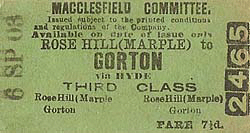 The growing business at Rose Hill, particularly residential traffic to Manchester, called for greater facilities, which were provided in the 1880s. The new facilities on the down side included a brick-built block with a pitched roof. The end-walls projected a short distance onto the platform as screens to partly enclose the awning which rose from the building at a slight angle and was supported by cast iron brackets; the depth of the valance was adjusted to offset the angle of the awning. Within the building were a ladies’ waiting room, with a lavatory, and a general waiting room. Later, as the Manchester bound business grew, a second booking office was provided by tacking a modest lean-to wooden structure onto the general room, with a booking window into the latter. The growing business at Rose Hill, particularly residential traffic to Manchester, called for greater facilities, which were provided in the 1880s. The new facilities on the down side included a brick-built block with a pitched roof. The end-walls projected a short distance onto the platform as screens to partly enclose the awning which rose from the building at a slight angle and was supported by cast iron brackets; the depth of the valance was adjusted to offset the angle of the awning. Within the building were a ladies’ waiting room, with a lavatory, and a general waiting room. Later, as the Manchester bound business grew, a second booking office was provided by tacking a modest lean-to wooden structure onto the general room, with a booking window into the latter.
On 1 August 1897 the MSLR changed its name to the Great Central Railway (GCR).
At the beginning of the twentieth century the goods yard was extended by the addition of a second siding to deal with the growing coal traffic, and a weighbridge was provided near the road entrance. At the same time the NS opened a new signal box close to the site of the original.
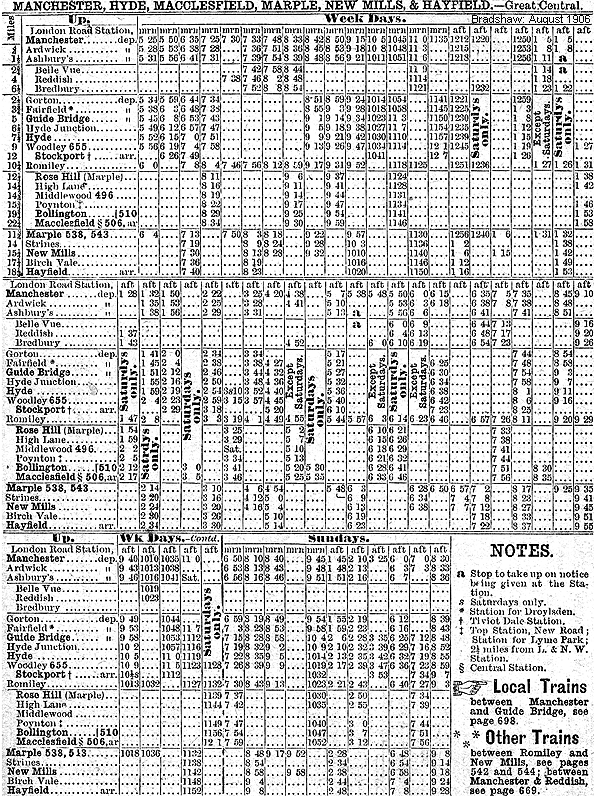
In 1908 the MC altered its title to the GC/NSR Joint Committee.
At the start of the First World War there was a reduction in services including the complete withdrawal of the NS Macclesfield and Buxton trains. However the reductions were soon considered unnecessary, and before the conflict had ended there were almost as many trains running as there had been in 1914.
After the war there was extensive housing development around Rose Hill station which made it a much busier place. Many of the new residents used Rose Hill to commute to Manchester and extra services were put on some of which terminated at the station.
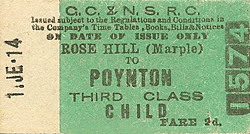 On 1 January 1923 the GCR became part of the London North Eastern Railway (LNER) and the NS became part of the London Midland & Scottish Railway (LNER). As a result Rose Hill and the MC line became the joint property of the two companies. The LNER, as successor to the GCR, provided the train services. On 1 January 1923 the GCR became part of the London North Eastern Railway (LNER) and the NS became part of the London Midland & Scottish Railway (LNER). As a result Rose Hill and the MC line became the joint property of the two companies. The LNER, as successor to the GCR, provided the train services.
By 1938 Rose Hill had 11 up and 18 down trains on weekdays. Five of the down trains were services that had terminated at Rose Hill from Manchester. The terminating services ran round at Rose Hill and the loco usually ran tender first to Manchester. However, with the outbreak of the Second World War on 3 September 1939, there was a drastic reduction in services. After the war the service had recovered and the LNER summer timetable for 1947 showed 13 trains to Macclesfield Central and 15 to Manchester London Road Monday-to-Friday. There were extra services on Saturdays and 6 trains in each direction on Sundays.
The station has generally been referred to in timetables as Rose Hill (Marple). However, comparison of the summer 1946 LMS and LNER public timetables reveals inconsistency, in that the LMS described it as Marple (Rose Hill) whilst in the LNER timetable it remained Rose Hill (Marple).
On 1 January 1948 Rose Hill became part of British Railways (London Midland Region) (BR[LMR]) and the region’s first timetable rendered the name Rose Hill (Marple) rather than the reversed form used by the LMS in 1946. However photographs from 1954 show the running-in nameboards reading ‘Marple – Rose Hill’; the name is in an unusual serif lettering which also found on the boards at other stations on the route. Although gas lighting was retained at the station it received LMR vitreous enamel running-in boards (‘Rose Hill Marple’, with ‘Marple’ in smaller print) and totem nameplates (‘Rose Hill’).
In the late 1950s DMUs were introduced onto the line. During the winter of 1957 Rose Hill had 12 trains to Macclesfield Central and 13 to Manchester London Road Monday-to-Friday with extra trains on Saturdays and there were still 6 in each direction on Sundays.
In 1960 Macclesfield Central station was rebuilt as the main line station for the town (replacing Hibel Road) and given the name Macclesfield. The creation of the new Macclesfield station provided good connections with services to London Euston for Rose Hill passengers for the first time. However the journey opportunities were not promoted as well as they might have been.
The September 1962 timetable showed 15 up and 19 down trains Monday-to-Friday. Four of the down services were trains that had terminated at Rose Hill from Manchester Piccadily (London Road had been renamed). There were extra trains on Saturday but the Sunday service had ceased to run.
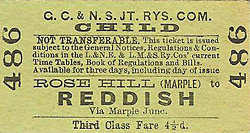 The Reshaping of British Railways (‘Beeching’) report of March 1963 earmarked the Romiley (Marple Wharf Junction) – Macclesfield line for closure to passengers. It was not until 29 December 1966 that formal publication of the proposal to withdraw this line’s passenger services took place, by which time many other condemned lines and stations had already closed; it is not known why the process was delayed. The closure hearings ended on 31 March 1967, but matters progressed slowly and it was not until 12 June 1969 that Richard Marsh, Secretary of State for Transport, consented to closure, but reprieved Rose Hill (Marple) station at the northernmost end of the branch, leaving it as the terminus. The line between Rose Hill Marple and Macclesfield closed completely on 5 January 1970 and track-lifting had been completed by March 1971. The Reshaping of British Railways (‘Beeching’) report of March 1963 earmarked the Romiley (Marple Wharf Junction) – Macclesfield line for closure to passengers. It was not until 29 December 1966 that formal publication of the proposal to withdraw this line’s passenger services took place, by which time many other condemned lines and stations had already closed; it is not known why the process was delayed. The closure hearings ended on 31 March 1967, but matters progressed slowly and it was not until 12 June 1969 that Richard Marsh, Secretary of State for Transport, consented to closure, but reprieved Rose Hill (Marple) station at the northernmost end of the branch, leaving it as the terminus. The line between Rose Hill Marple and Macclesfield closed completely on 5 January 1970 and track-lifting had been completed by March 1971.
By 1974 the original building on the up platform had been demolished; it was outlived by the similar building at the closed High Lane station, which was soon to be demolished too, so that none of the ‘line style’ buildings have survived. The later down platform building at Rose Hill was retained, but by 1974 its canted awning had been replaced with a flat design. Double track was retained through the station for some years but it had been singled by 1982, serving the former down platform. The up platform has subsequently been removed.
When the route to the south closed, the May 1970 timetable showed an approximately hourly weekday service to and from Rose Hill, enhanced at morning and evening peak hours on Monday-to-Friday, and no trains on Sunday. In summer 1989 the Saturday service was increased to two trains per hour, the additional train operating via Bredbury rather than Guide Bridge, but this was discontinued in May 1992. Since December 2010 there have been two weekday off-peak trains per hour. At first there was one fast Manchester Piccadilly service calling only at Romiley and a stopping service via Guide Bridge, but now both services operate via Guide Bridge.
Sources:
To see other stations on the Marple and Macclesfield line click the name:
High Lane, Middlewood Higher, Higher Poynton, Bollington,
Macclesfield MSLR/NS and Macclesfield Central |

hill_old7.jpg)
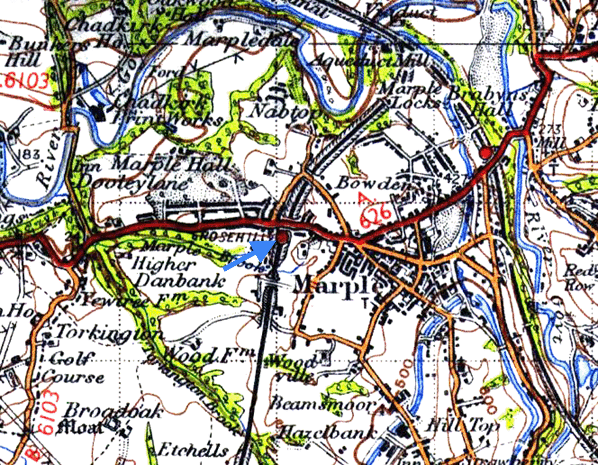
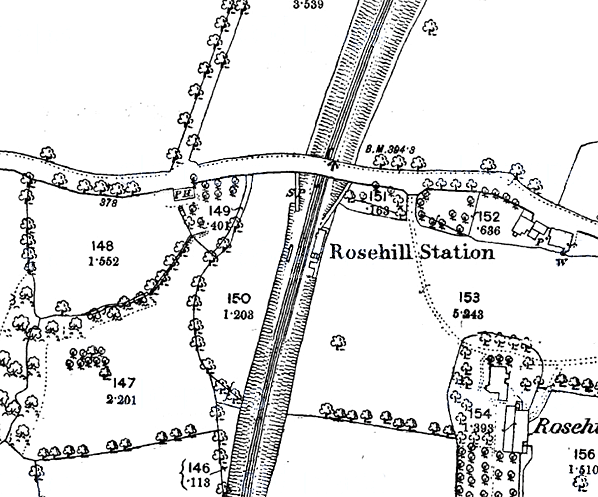
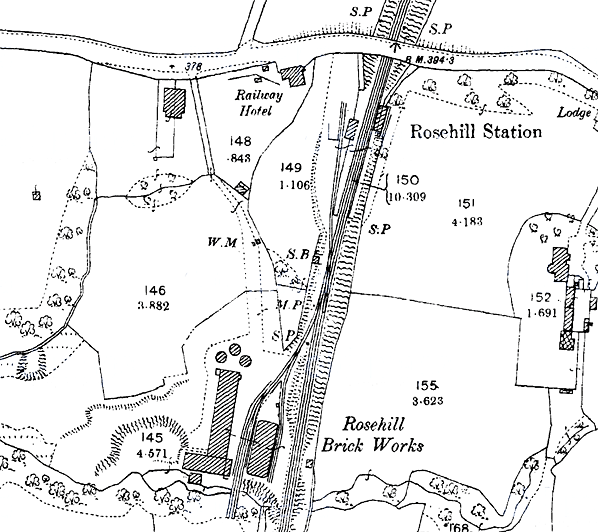
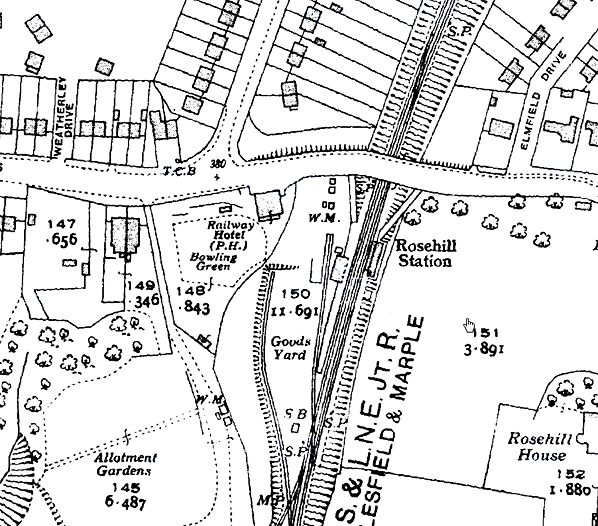 Rose Hill shown on a 1934 1:2,500 OS map. By the 1930s there had been a great deal of housing development around Rose Hill station. The spread of the suburbs led to Rose Hill becoming one of the busiest stations on the Macclesfield and Marple line which ultimately saved it from closure. A weighbridge is shown at tne entrance to the yard.
Rose Hill shown on a 1934 1:2,500 OS map. By the 1930s there had been a great deal of housing development around Rose Hill station. The spread of the suburbs led to Rose Hill becoming one of the busiest stations on the Macclesfield and Marple line which ultimately saved it from closure. A weighbridge is shown at tne entrance to the yard.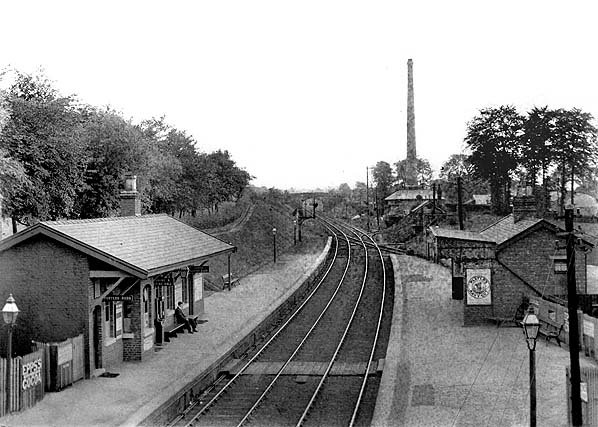
hill_old4.jpg)
hill_old8.jpg)
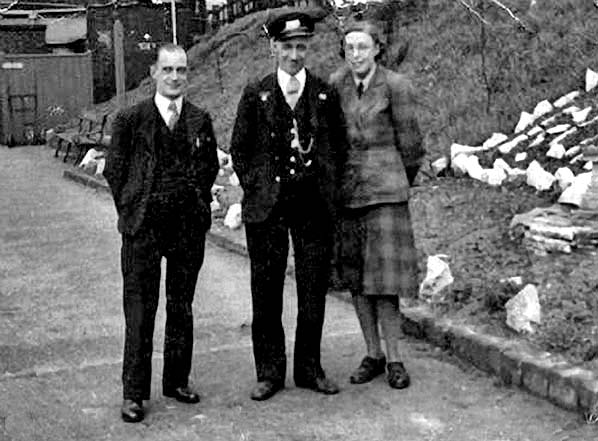
hill_old1.jpg)
hill_old2.jpg)
hill_old3.jpg)
hill4.jpg)
hill5.jpg)
hill6.jpg)
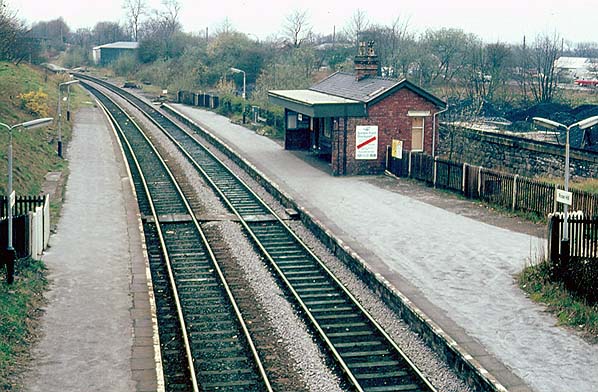

 When Rose Hill opened it was in a sparsely populated area to the west of Marple. The station was located on the south side of Stockport Road which passed over the line on a bridge. Originally the line was single-track and the platform was located on the east side of the line. Access was via a sloping path that connected the platform to Stockport Road. The station building was of a style also used at Higher Poynton, High Lane and Bollington stations. It was an austere single-storey brick building whose pitched roof extended forward as a platform canopy, supported by a series of unadorned wooden brackets. Accommodation consisted of four rooms all entered from the platform - a porters’ room, at the north, followed by the station office, with a booking window to the adjoining general waiting room-cum-booking office; a ladies’ room with lavatories completed the facilities, with a brick-built gents’ lavatory adjoining. The only architectural feature of note was a small square bay, with clock, projecting from the station office.
When Rose Hill opened it was in a sparsely populated area to the west of Marple. The station was located on the south side of Stockport Road which passed over the line on a bridge. Originally the line was single-track and the platform was located on the east side of the line. Access was via a sloping path that connected the platform to Stockport Road. The station building was of a style also used at Higher Poynton, High Lane and Bollington stations. It was an austere single-storey brick building whose pitched roof extended forward as a platform canopy, supported by a series of unadorned wooden brackets. Accommodation consisted of four rooms all entered from the platform - a porters’ room, at the north, followed by the station office, with a booking window to the adjoining general waiting room-cum-booking office; a ladies’ room with lavatories completed the facilities, with a brick-built gents’ lavatory adjoining. The only architectural feature of note was a small square bay, with clock, projecting from the station office. The growing business at Rose Hill, particularly residential traffic to Manchester, called for greater facilities, which were provided in the 1880s. The new facilities on the down side included a brick-built block with a pitched roof. The end-walls projected a short distance onto the platform as screens to partly enclose the awning which rose from the building at a slight angle and was supported by cast iron brackets; the depth of the valance was adjusted to offset the angle of the awning. Within the building were a ladies’ waiting room, with a lavatory, and a general waiting room. Later, as the Manchester bound business grew, a second booking office was provided by tacking a modest lean-to wooden structure onto the general room, with a booking window into the latter.
The growing business at Rose Hill, particularly residential traffic to Manchester, called for greater facilities, which were provided in the 1880s. The new facilities on the down side included a brick-built block with a pitched roof. The end-walls projected a short distance onto the platform as screens to partly enclose the awning which rose from the building at a slight angle and was supported by cast iron brackets; the depth of the valance was adjusted to offset the angle of the awning. Within the building were a ladies’ waiting room, with a lavatory, and a general waiting room. Later, as the Manchester bound business grew, a second booking office was provided by tacking a modest lean-to wooden structure onto the general room, with a booking window into the latter.
 On 1 January 1923 the GCR became part of the London North Eastern Railway (LNER) and the NS became part of the London Midland & Scottish Railway (LNER). As a result Rose Hill and the MC line became the joint property of the two companies. The LNER, as successor to the GCR, provided the train services.
On 1 January 1923 the GCR became part of the London North Eastern Railway (LNER) and the NS became part of the London Midland & Scottish Railway (LNER). As a result Rose Hill and the MC line became the joint property of the two companies. The LNER, as successor to the GCR, provided the train services. The Reshaping of British Railways (‘Beeching’) report of March 1963 earmarked the Romiley (Marple Wharf Junction) – Macclesfield line for closure to passengers. It was not until 29 December 1966 that formal publication of the proposal to withdraw this line’s passenger services took place, by which time many other condemned lines and stations had already closed; it is not known why the process was delayed. The closure hearings ended on 31 March 1967, but matters progressed slowly and it was not until 12 June 1969 that Richard Marsh, Secretary of State for Transport, consented to closure, but reprieved Rose Hill (Marple) station at the northernmost end of the branch, leaving it as the terminus. The line between Rose Hill Marple and Macclesfield closed completely on 5 January 1970 and track-lifting had been completed by March 1971.
The Reshaping of British Railways (‘Beeching’) report of March 1963 earmarked the Romiley (Marple Wharf Junction) – Macclesfield line for closure to passengers. It was not until 29 December 1966 that formal publication of the proposal to withdraw this line’s passenger services took place, by which time many other condemned lines and stations had already closed; it is not known why the process was delayed. The closure hearings ended on 31 March 1967, but matters progressed slowly and it was not until 12 June 1969 that Richard Marsh, Secretary of State for Transport, consented to closure, but reprieved Rose Hill (Marple) station at the northernmost end of the branch, leaving it as the terminus. The line between Rose Hill Marple and Macclesfield closed completely on 5 January 1970 and track-lifting had been completed by March 1971. 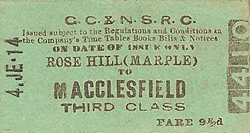
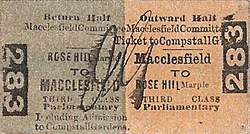
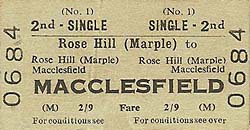
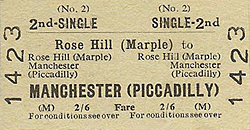
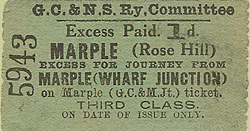

 Home Page
Home Page